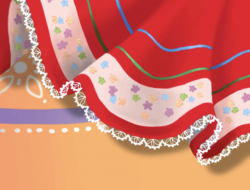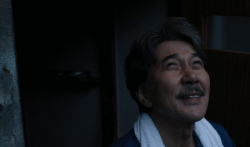Julia Fullerton-Batten may have survived puberty, but she certainly didn’t make it out unscathed. Her photographic repertoire has thus far captured the fragility and instability of adolescence with an eerie, disquieting surrealism.
Her new works, part of the collective “In Between” exhibit at the Randall Scott Gallery, mark a transition, both in those awkward years she remains enthralled with, and in her photography, one which is quieter yet still profoundly disturbing.
German-born Fullerton-Batten has received much international acclaim, and in glancing through the catalogue of her previous work, it is clear why. Her construction of elaborate, intensely psychological scenes easily catch one’s attention, and the dramatic message is generally straightforward.
In her photo “Changing Room,” for instance, a group of young girls clad in nude swimsuits stare down a victim of life’s natural (and messy) cycle: a young girl postured almost like Botticelli’s Venus stands uncomfortably in the center, covering her developing breasts while a trickle of blood streams down her leg.
But her new work diverges from these overtly uncomfortable settings. Although less appealing at first glance—Fullerton-Batten eliminates the visually enthralling, fairy-tale scenes and larger-than-life figures which characterized much of her earlier photography—her “In Between” photographs capture a calm yet disturbing stillness within movement, the tumultuous transition into adolescence orchestrated in the realm of the mundane.
In “Bedroom,” a girl floats at the foot of her bed, as the canopy drapes waft in the air, propelled by a mysterious gust of wind. A glass of spilled milk on the floor contributes a moment of tension and anxiety to the scene. The peculiar floating position of the model, a recurring characteristic in the works on display, emphasizes the in-between-ness of adolescence. The posture of seemingly forward movement is made awkward by a strange backward pull, also emphasized in “Mirror.”
Though her works strike at a universal notion—that awkward period everyone endures—Fullerton-Batten’s subjects inhabit a particular space. Her models are primarily white, and her scenes take place in upper-middle-class suburbia, where she spent some of her childhood years while living in America. But the mundane and secure surroundings emphasize the disturbing imagery within them. Rather than using professional models, Fullerton-Batten employs average girls, which authenticates her work and the internal psychology of her subjects.
Her new works are perhaps not as visually rich as her former series. In thumbing through the catalogue, I found myself more interested in the heavily orchestrated scenes of private school games and oversized models within miniaturized suburban-scapes of her previous works.
But after getting lost in her fantasy world of adolescence, one can appreciate her new artistic direction. Fullerton-Batten has certainly toned down her work—colors are lighter and more natural—but they speak of a more understated drama: that of the young girl in isolation. Her subtleties, such as a glass of spilled milk or the scattered sheet music of a young violin player, contribute a quieter, internal drama that is, in some ways, more vulnerable and honest.
“In Between” is currently on display at the Randall Scott Gallery through October 18. The gallery is located at 1326 14th St NW and is open Wed.-Sat. 11am -6pm and Tuesday by appointment.




